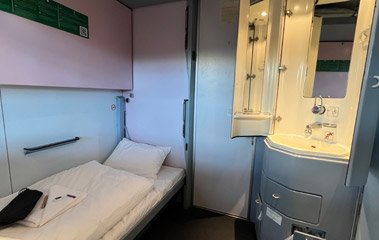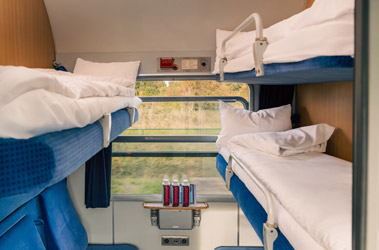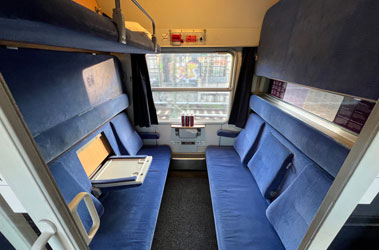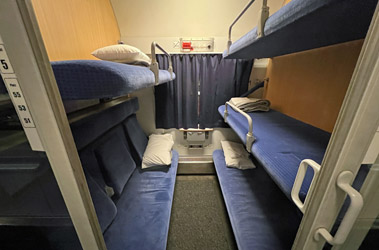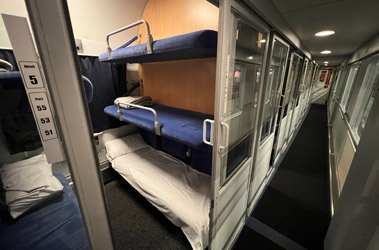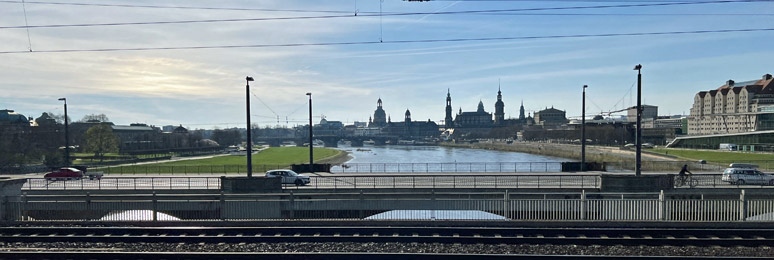 |
|
|
Brussels/Amsterdam <> Berlin/Dresden/Prague |
Brussels, Amsterdam ► Berlin, Dresden, Prague
On 25 May 2023, new open-access train operator European Sleeper (www.europeansleeper.eu) launched a sleeper train linking Brussels, Antwerp, Rotterdam & Amsterdam with Berlin, 2 or 3 times a week. On 25 March 2024 it was extended to Dresden & Prague. It has an easy connection from London to Brussels by Eurostar, or by ferry from Harwich to Hoek van Holland to pick up the sleeper in Rotterdam.
![]() Comfort Standard = almost as
good as a sleeper
Comfort Standard = almost as
good as a sleeper
![]() Tips: Luggage, bikes,
pets, food, where to wait
Tips: Luggage, bikes,
pets, food, where to wait
![]() Wake up to the scenic route &
watch the videos
Wake up to the scenic route &
watch the videos
![]() Rotterdam Centraal
station guide
Rotterdam Centraal
station guide
![]() Amsterdam Centraal station
guide
Amsterdam Centraal station
guide
Train times 2026
Why 13:01 Eurostar from London, not 15:04? The European Sleeper is sometimes retimed an hour earlier at a week's notice, so I suggest playing safe and booking the 13:01. I recommend the Pullman Hotel bar at Brussels Midi as your VIP departure lounge, or even visit Brussels' Grand Place.
Why 12:56 Eurostar back to London, not 10:52? The European Sleeper is sometimes retimed at a week's notice to arrive in Brussels an hour later, so play safe!
Ferry connection from London & Harwich: If you prefer a ferry, live in East Anglia, or if Eurostar is expensive, you can travel from London to Rotterdam using Stena Line's daytime ferry from Harwich to Hoek van Holland, picking up the sleeper in Rotterdam, see the UK-Germany page.
This is the normal timetable. Always check times for your specific date of travel as they may vary due to trackwork. For example, the train occasionally uses Berlin Gesundbrunnen instead of Berlin Hbf. Check times for specific dates at www.europeansleeper.eu or int.bahn.de (use plain BERLIN not Berlin Hbf).
On other days of the week: Starting 26 March 2026, European Sleeper will also offer a Brussels to Berlin sleeper on Tue, Thur, Sun, returning Berlin to Brussels on Mon, Wed, Fri, with connections from/to London, for details see the European Sleeper Paris-Brussels-Berlin page.
How much does it cost?
-
London to Brussels by Eurostar starts at £51 one-way or £78 return in Standard, £98 one-way, £140 return in Plus (1st class).
Fares work like air fares, so book ahead.
-
Brussels, Rotterdam or Amsterdam to Berlin, Dresden or Prague by sleeper:
In a seat (budget): From €49,
In a couchette (classic): From €79 with a couchette in 6-berth, €99 with a couchette in 5-berth.
In a sleeper (comfort): From €109 with a bed in 3-bed sleeper, €129 with a bed in 2-bed sleeper, €159 with a bed in single-bed sleeper.
All prices per person per berth. Fares vary like air fares, so book ahead.
Children under 4 travel free, without their own berth. Children under 12 travel at a child rate.
For Interrail & Eurail reservation fees, see the Interrail/Eurail reservation page.
How to buy tickets
-
Book at www.europeansleeper.eu.
Booking opens up to 6 months ahead, although this can vary.
You print your own ticket or can show it on your phone.
If you have an Interrail or Eurail pass, change 1x Adult to Reservation only.
-
Book your London-Brussels Eurostar separately at www.eurostar.com.
By all means book an earlier Eurostar outward or a later one on the return, if this has cheaper fares available or if you'd like more time between trains in Brussels. Booking opens up to 11 months ahead. You print your own ticket or can show it on your phone.
What's the train like?
European Sleeper uses three terms when you book: Comfort, Classic & Budget. If you select comfort you'll get a choice between comfort plus, which means beds in the sleeping-car, or (new from December 2025) comfort standard which means a couchette compartment sold as a single, double or triple and made up with proper bedding including mattresses.
Comfort plus = sleeping-car
Sold as comfort plus, the train has one or sometimes two sleeping-cars, instantly recognisable by their American-style fluted stainless-steel body. 80 of these cars were built in 1954-56, originally with 20 small upper & lower single compartments, named the P type after their designer Albert Pillepich of the famous Compagnie Internationale des Wagons-Lits. A number of P types were completely rebuilt in the 1990s for the Austrian, Belgian & Dutch railways with a more conventional 10-compartment layout and were reclassified AB30 (AB = 1st & 2nd class, 30 = 30 berths).
The sleeping-car has 10 compartments, each can be sold as 1, 2 or 3 berth with upper, middle & lower berths folded out as required. Luggage goes in the large recess over the door to the corridor or over the window. The compartments have normal locks and a security deadbolt which can only be locked & unlocked from inside. There's a washbasin, soap, towel, complimentary slippers and all necessary bedding including a very comfortable duvet. A bottle of drinking water is provided for each passenger. Morning tea or coffee and a breakfast box are included in the fare. There are two toilets at one end of the corridor.
There's a 2-pin European-style power outlet in the washstand, if you open the washstand doors you'll find it in the ceiling, it works for recharging phones.
The Man in Seat 61 says: "I have a soft spot for these venerable sleeping-cars. They're old but comfortable, and with only 10 compartments not 12 in a 24-metre car they are relatively spacious by European sleeper standards. It's true they can be temperamental, they like the German power supply better than Belgian or Dutch, you may find the water pressure and air-con better on the German side! With friendly staff, comfortable beds and breakfast included it's a great way to travel."
Tip: If you find the sleepers fully-booked (they sell out first), a private compartment in a 5-berth couchette car makes a decent alternative.
The stainless-steel sleeping-car on a westbound European Sleeper, about to leave Berlin Hbf. Click the interior photos for larger images.
Comfort standard = couchette set up as a sleeper
Since December 2025, European Sleeper have set up some couchette compartments as single, double or triple with the bunks made up as proper beds with comfy mattress, pillow and duvet. Sold as comfort standard, they're almost as comfortable as a proper sleeper and just as private for one, two or three people, although without a washbasin and breakfast is optional not included. One advantage over a sleeper is that the window opens, for reflection-free photography in the Elbe valley.
Standard Comfort compartment, set up as a single (above left) and triple (above right). Courtesy of European Sleeper.
Classic = 5-berth couchettes
Sold as classic, these are 5-berth compartments in air-conditioned couchette cars built for German Railways in the 1990s. Each of the 9 compartments has 5 berths, upper & lower on one side, upper, middle & lower on the other.
Each berth is provided with a clean sheet, blanket & pillow. There is a toilet and 1 or 2 washrooms at each end of the corridor. The compartment door has a normal lock and a security chain. A bottle of drinking water is provided for each passenger and you can buy snacks & drinks from the train staff. A light breakfast with tea or coffee can be added to your booking when you buy tickets or bought from staff on board. Compartment windows open, one or two corridor side windows also open. Couchette compartments are not segregated by gender as you do not normally get fully undressed, but women can book a berth in a ladies-only compartment. See couchette car numbering plan.
If you want sole occupancy of a whole 5-berth compartment for 2-5 people, you will see a price for a private compartment when you book. If you find the sleeping-car fully-booked, sole occupancy of a 5-berth couchette compartment is a decent alternative.
Above, the inaugural European Sleeper departure waits to leave Prague on Tuesday 26 March 2024. Click the interior photos for larger images.
Budget = seats
Sold as budget, there are one or more seats cars, but I don't recommend seats for an overnight journey, always book a sleeper or couchette unless unavoidable.
Route map
Click for larger map Highlighted = Brussels-Amsterdam-Berlin-Prague sleeper route. Green = scenic sections. Red = high-speed lines.
Reproduced from the excellent European Rail Map with kind permission of the European Rail Timetable people. I recommend buying the European Rail Map for your travels and a copy of the European Rail Timetable, www.europeanrailtimetable.eu with shipping worldwide.
Tips: Luggage, bikes, pets, food...
-
Sleeper, couchette or just a seat?
For solo travellers on a budget, a couchette is fine, you get a flat bunk in a safely lockable compartment and can sleep just as well as in a sleeper - never travel in just a seat, always book a couchette or sleeper on a night train for both comfort and security.
It's worth paying the extra for a couchette in a 5-berth compartment as you get more space per person than in 6-berth and in a nicer car with air-conditioning, too. If you're tall, a lower berth is better as the upper berth support chains can get in the way of your feet and head.
For families, a 5 or 6 berth couchette compartment is ideal, you're all together in one compartment and can have a blast - bring a bottle of wine for mum & dad. Paying more for two 2-berth compartments in the sleeping-car probably isn't worth it (unless you've older kids and mum & dad want a break). There are whole-compartment rates for sole occupancy of a 5 or 6 berth compartment, or you can add phantom children to your booking to fill a 5 or 6 berth compartment.
The sleeping-car has a quieter, more civilised atmosphere, and it's obviously the best option for solo travellers & couples not budget-limited. Some families and many solo travellers prefer it: A bed in a shared 3-bed single-gender sleeper doesn't cost that much more than a bunk in a 4-berth couchette compartment. In the sleeper, you get a proper fully-made-up bed with duvet.
-
Berth numbering
It often confuses people when they get berths 21 & 25 and think they aren't together in the same 2-berth sleeper compartment. Of course they are! See how sleepers are numbered. See how couchettes are numbered.
In the 5-berth couchettes, the middle berth number on one side isn't used. However, in some compartments the left hand side has 2 berths, the right hand side 3, in other compartments it's the other way round.
-
How to check the train formation
You can see the train formation with car numbers and photos of each car at www.vagonweb.cz: Change cs to English, click Train formations and search for European Sleeper.
However, actual formations change, the specific formation of today's departure can be found at www.europeansleeper.eu. Look under Travel info for Train composition.
-
Luggage
You take your luggage with you into your compartment and simply stick it on the luggage racks above the window, in the big recess over the door to the corridor, or on the floor. Nobody weighs it, measures it, or worries about how much you take. More about luggage on European trains.
-
Bikes
Bikes are carried on the European Sleeper for €19. They are carried in a large bike compartment in the seats car at one end of the train.
Update: Unfortunately, the bike carriage is only now attached at certain times of year, check online.
For bikes on Eurostar, see the bikes by train page. However, I recommend taking bikes on the bike-friendly Harwich-Hoek ferry and picking up the European Sleeper at Rotterdam.
-
Dogs & other pets
Pets are carried on the sleeper free of charge, as long as you (and anyone with you) occupy a whole sleeper or couchette compartment.
Pets are not carried on Eurostar, but can be carried on the London-Amsterdam train-ferry-train service to pick up the sleeper in Rotterdam.
-
Wheelchairs
Unfortunately, European Sleeper have not been able to get hold of the very few available couchette cars with wheelchair-accessible compartments, but longer term they want to add this facility.
-
WiFi & power sockets
There's no WiFi, but mobile data reception works fine along most of the route. There are power sockets (European 2-pin type) in most of the 5-berth couchette cars, but not in all the 6-berth couchette compartments. In the sleeping-car, there's a 2-pin socket in the ceiling of the washstand, it's intended for shavers but can be used to recharge phones. I always travel with a powerbank.
-
Food & drink on board
There's no restaurant car, so eat before you board or bring a picnic and bottle of wine!
You'll find a menu card listing snacks & drinks in you sleeper or couchette compartment, it includes tea, coffee, soft drinks, red & white wine, beer, nachos & noodles. Order from the train staff, or scan the QR code on the menu and order snacks & drinks on your phone, staff will bring it to your compartment. You can pay in euros or by card.
-
Where to wait for your train
In Brussels, the Pullman Hotel bar makes the best VIP waiting room away from the hustle and bustle, it's an integral part of the station.
In Rotterdam, for dinner or a beer before taking the sleeper, try Kaapse Maria (www.kaapsebrouwers.nl) for craft beer and good pub food, 9 minutes walk from Rotterdam Centraal, see walking map. Check opening hours, it's open Monday & Friday but closed Wednesdays. Alternatively, Le Nord (lenord.nl), La Cazuela & Dunya are all good bistros in a quiet road 5 minutes north of the station, see walking map.
In Berlin, the best VIP waiting room is the bar of the Steigenberger Hotel, just outside the station's main exit to the right. Friendly staff, a quiet location and they do food, too.
In Prague, have a coffee at the Fantova Kavárna in the historic old station hall, away from the hustle & bustle of the modern station below. Also consider the Foyer Cafe, a new upmarket cafe-bar opened in 2024 in a magnificent high-ceiling room in the old station building.
Always check up to date departure times using int.bahn.de, I suggest using plain BERLIN rather then Berlin Hbf.
-
Early arrival in Berlin? No problem, drop off your bags at reception at InterCity Hotel Berlin Hbf just outside the station (or if you're flush, the equally excellent Steigenberger Hotel) and ask to pay for the hotel's breakfast buffet!
-
Does it run on time?
For a train running such a distance it's usually pretty good. But see for yourself using Zugfinder.net: Eastbound performance over last 30 days. Westbound performance over last 30 days.
Wake up to the scenic route to Prague!
Between Dresden, Bad Schandau, Děčín, Ústí nad Labem and Prague, the European Sleeper follows the same scenic route along the River Elbe as the daytime EuroCity trains. The photos below were taken from the inaugural European Sleeper to Prague on the glorious morning of 26 March 2024.
Shortly after 6am, the eastbound European Sleeper arrives at Berlin Hbf on its way to Prague.
Soon after 8am, the European Sleeper calls at Dresden Neustadt, then crosses the river Elbe with the spires of historic Dresden as a backdrop.
From 08:40 until around 10:00, the European Sleeper runs along the beautiful Elbe river valley between Dresden & Prague.
The rocky section of the river Elbe. At this point, we're still in Germany near Bad Schandau.
Soon after calling at Bad Schandau, the train crosses the border into Czechia and passes Hřensko on the far bank.
The European Sleeper approaches Děčín station, with views of Děčín castle on the opposite bank of the Elbe.
The European Sleeper arrived at Prague Hlavni.
Watch the videos
This video shows the sleeping-car, 6-berth couchettes, seats & bike spaces, filmed on the inaugural journey from Brussels to Berlin on 25 May 2023.
This video shows the 5-berth couchettes and scenery between Berlin & Prague, filmed on the inaugural journey from Brussels to Prague on 25 March 2024.
About European Sleeper
European Sleeper isn't just an ordinary company, it's on a mission to bring sleeper trains back. Founded by two entrepreneurs with a passion for sleepers, Elmer van Buuren and Chris Engelsman, it has required a huge effort battling railway bureaucracy to get this train up and running. It's been particularly difficult to source serviceable rolling stock as there's so little available for hire, but they've done it and they now have a comfortable and operationally robust train even though it inevitably uses older rolling stock. They are now working on expanding the offer and in the longer term funding and sourcing the modern rolling stock that this service deserves. Let's give them our support!
I was privileged to be at the launch reception on 26 May 2023 at the Pullman Hotel at Brussels Midi. On stage are European Sleeper founders Elmer van Buuren (left) and Chris Engelsman (centre) with Dutch-American comedian Greg Shapiro hosting the event. Photographed by the author.






